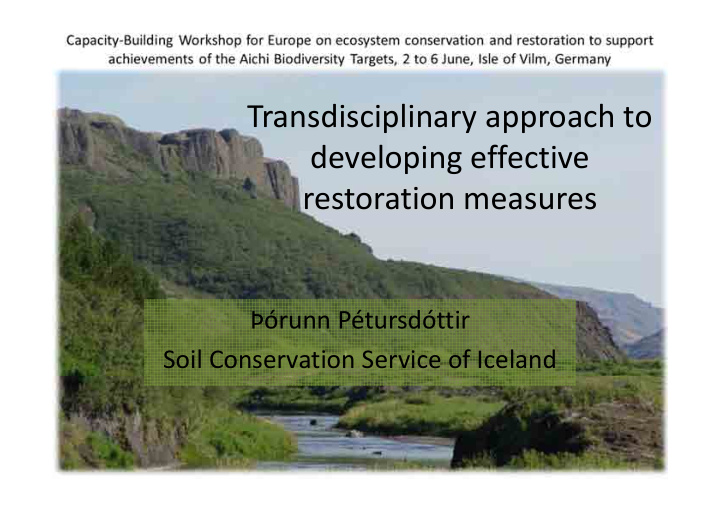



Transdisciplinary approach to developing effective restoration measures Þórunn Pétursdóttir Soil Conservation Service of Iceland
Ecological Restoration “An intentional activity that initiates or accelerates the recovery of a (degraded) ecosystem with respect to its functions, integrity and sustainability“ ( ser.org ) A cross-disciplinary activity! • Ecological restoration is an engaging and inclusive process . Restoration embraces the interrelationships between nature and culture, engages all sectors of society, and enables full and effective participation of indigenous, local and disenfranchised communities. • Ecological restoration requires the integration of knowledge and practice . Science and other forms of knowledge are essential for designing, implementing and monitoring restoration projects and programs. At the same time, lessons learned from practical experiences are essential for determining and prioritizing the scientific needs of the field. • Ecological restoration is policy-relevant and essential . Restoration is a critical tool for achieving biodiversity conservation, mitigating and adapting to climate change, enhancing ecosystem services, fostering sustainable socioeconomic development, and improving human health and well-being. • Ecological restoration is practiced locally with global implications . Restoration takes place in all regions of the world, with local actions having regional and global benefits for nature and people. Island Press Book Series on ecological restoration (ser.org)
EGOLOGICAL RESTORATION AS PART OF RESILIENCE-BASED MANAGEMENT Degraded ecosystems/Unsustainable SESs Economic Biotic Evidence-based policies Societal Environmental Abiotic inputs inputs Social Restoration information information cohesion Financial support ecology Social Technic Political outputs outputs feedback feedback Ecological restoration Ecological outcome Social outcome Economic outcome impact impact Collaboration/ Paradigm shift Market values transparency Evaluation Evaluation Non-market Ecosystem Ecosystem functions structure values impact impact Petursdottir et al. Restored ecosystems/Sustainable SESs In manuscript
SES resilience – a conceptual model Disruption Adaptive Degradation Disturbance management Ecology Society Ecology Society R- *R- R+ R+ R- R+ R+ R- U NSUSTAINABLE SYSTEM S USTAINABLE SYSTEM Inadequate Behavior Intervention Restoration Behavioral Based on: Holling 2001 and changes *R = resilience/resistance Carpenter et al. 2001 (Petursdottir et al., in manuscript)
An estimate of birch woodlands at the time of settlement (around 900 AD) Source: Iceland Forest Service
The extent of birch woodlands in 1990 Source: Iceland Forest Service
Ecosystem degradation 150 km 0
R ESTORATION IN I CELAND 1907-2010 • Iceland: 103.000 km 2 • 43.000 km 2 <50% vegetation cover – Roughly 80% of Icelandic ecosystems can be defined as rangelands – majority utilized for sheep grazing RESTORED AREAS: • Heathland/grassland: 2300 km 2 • Woodland: 192 km 2 • Wetland: 26 km 2 Aradottir et al. 2013
“Drivers of Ecological Restoration: Lessons from a Century of Restoration in Iceland” Aradottir et al. 2013 IDEALISTIC PRAGMATIC BUREOCRATIC Conservation based Utilization based Policy based
Restoration project of a local primary school in the country side 2000-2005 Photos: Sigþrúður Jónsdóttir
Local landcare group operating in the common highlands in the South 2000 2005 Photo: Sigþrúður Jónsdóttir
Ássandur- Þingeyjarsýslu Previously collapsed ecosystem Fertilized in 1963 Birch and willow species re-colonizing 2004 Photos: Sveinn Runólfsson
CASE STUDY -collapsed to restored • Icelandic Hekla forest project – Since 2007 • Resilience-based – Capture pumish/ash • Planting seed banks – Seed spread by wind dispersal • Multiple benefits – Restoration – Afforestation, native species – Water storage – Protection/utilization – Recreation/aesthetic – Various stakeholders
Size of area under restoration: 900 km 2 (1% of Iceland) Private property Soil Conservation Service SCS and Local authorities Local authorities Local authorities Forestry Grazed rangeland Hekluskógar boundaries Roads Farms
Conditions Sparsely vegetated / much sandflux / Lyme grass - 1 Sparsely vegetated / little sandflux / grasses - 1b Partly vegetated / fertilizer - 2a Partly vegetated / tree planting - 2b Old lupine reclamation / tree planting -3 Fully vegetated / tree planting - 4 Over 600 m a.s.l. Grazed rangeland Private property Hekluskógar boundaries Rivers and lakes Roads Farms
Yes!
Þórsmörk
„Almenningar“ („Commons“)
Restoration activities Since 1990
Height: 264 m Cover: 40 % Plot 4 Biomass: 84 kg/ha
Plot 4b Height: Um 250 m Cover: 100 % Biomass: 264 kg/ha
Plot 6 Height: 296 m Cover: 40 % Biomass: 38 kg/ha
Height: 425 m Cover: 40 % Plot 9 Biomass: 57 kg/ha
„Hádegissker“ in Skógey area – a historical evidence Guðmundur Ómar Friðleifsson
Hoffellsjökull Glacial lake Glacier retreating
Glacial outburst Before 1980
Hornafjörður around 1980
Highly intensive management low ecological considerations – main purpose to protect the fishing village from drifting sand
2 years after intensive reclamation
Diverse vegetation • Natural distribution of native species • Birds • Wetland formation 2004
The effects of grazing on willows ONGOING CONFLICT... Grazed Protected
Þorlákshöfn
But – they used a restorationcompensation fund, established in relation to the construction of a geothermal power plant to install optical fibre cable to improve their internet connection...
Gunnarsholt´s stream
Gunnarsholt´s stream
For the group exersice: • What are the three main types of degradation in your country? • In accordance to the 4-level model of the EU, what is their level of degradation? • What are the potentials for their restoration, in the social-ecological context? Several useful links: www.ser.org – http://chapter.ser.org/europe/ http://www.desire-project.eu/ http://www.recare-project.eu/ http://desertrestorationhub.com/ http://www.globalrestorationnetwork.org/ IUCN (the Ecosystem Approach)
Recommend
More recommend